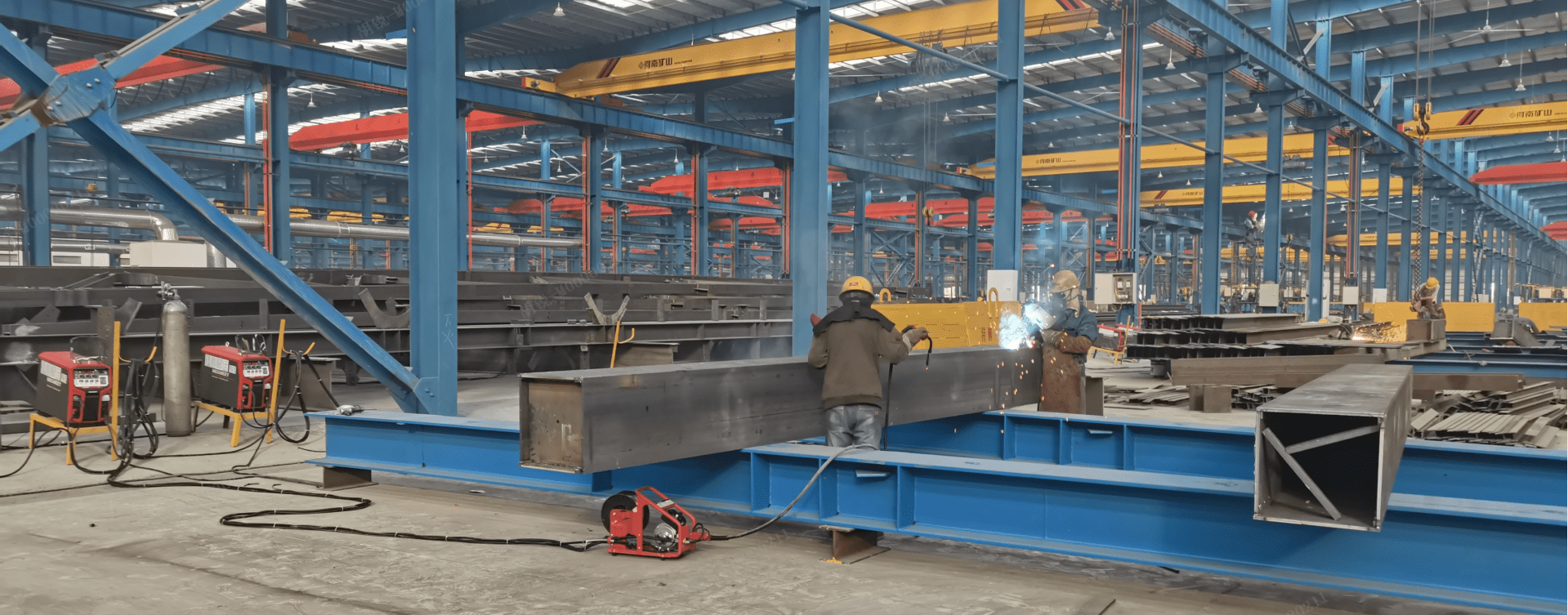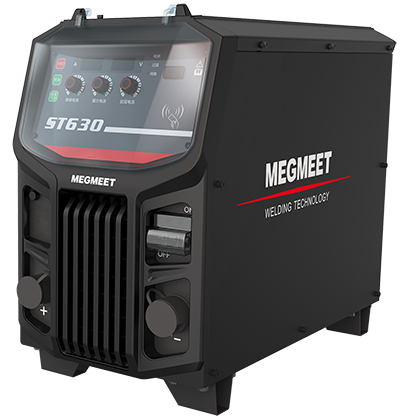Steel structures form the backbone of modern construction, from towering skyscrapers and sprawling bridges to industrial facilities and infrastructure. The integrity and strength of these structures rely heavily on the quality of their welded joints. Selecting the appropriate welding method is crucial for ensuring safety, efficiency, and durability in steel structure fabrication.

This guide will delve into the most common welding processes employed for joining steel structural components, outlining their principles, advantages, and typical applications.
I. Why Welding is Critical for Steel Structures
Welding is the primary method for joining steel structural elements because it creates strong, continuous connections that can withstand significant loads and stresses. Unlike bolting or riveting, welding fuses the materials, often resulting in a joint that is stronger than the base metal itself.
However, steel structure welding is a process that demands high techniques. To ensure welding quality, strict standards must be followed. In China, major reference standards include "Steel Structure Welding Quality" (GB/T 3323) and "Steel Structure Engineering Welding Technical Specification" (GB 50661). Internationally, commonly used standards are the American Welding Society (AWS) D1.1 standard and the European welding standard EN 1090. Adhering to these standards ensures that welding quality meets national and industry requirements, reduces accident risks, and improves engineering reliability.
II. The Most Common Welding Methods for Steel Structures
Several welding processes are commonly used in steel structure fabrication. The choice of method depends on factors like the thickness of the steel, the required welding position, the project's budget, production volume, and environmental conditions.
Here are the most prevalent methods:
Principle: An electric arc is created between a consumable electrode (covered with flux) and the base metal. The flux melts and provides a shielding gas to protect the weld pool from atmospheric contamination.
Advantages: Highly versatile, portable, relatively inexpensive equipment, suitable for various welding positions, good in windy conditions due to slag shielding.
Disadvantages: Lower deposition rates compared to wire processes, requires frequent electrode changes, generates slag that needs to be removed.
Typical Applications: Field welding, repair work, less critical joints, tack welding, and applications where portability is essential. While used in structural steel, it's often supplemented or replaced by wire processes for higher productivity.

2. Flux-Cored Arc Welding (FCAW):
Principle: Uses a continuous tubular electrode filled with flux. The flux provides shielding gas (sometimes supplemented by external gas) and can add alloying elements.
Advantages: High deposition rates, good penetration, suitable for out-of-position welding (especially self-shielded FCAW), less sensitive to wind than GMAW, produces a slag that can help shape the weld.
Disadvantages: Produces slag that needs removal, can generate fumes, and requires proper ventilation.
Typical Applications: Shop fabrication and field welding of structural steel, heavy plate welding, and applications requiring higher productivity than SMAW. Both gas-shielded (FCAW-G) and self-shielded (FCAW-S) variations are used.
Principle: Uses a continuous solid wire electrode and an external shielding gas (typically Argon or Argon mixtures for steel).
Advantages: High deposition rates, clean welds with minimal slag, relatively easy to learn, good for automated welding.
Disadvantages: Requires external shielding gas (susceptible to wind), less effective for out-of-position welding compared to FCAW-S, can struggle with dirty or rusty surfaces.
Typical Applications: Shop fabrication of structural components, automated welding lines, joining thinner sections of steel, and applications where high productivity and minimal cleanup are desired.
Principle: Uses a continuous solid or flux-cored electrode, and the arc is submerged beneath a granular flux. The flux provides shielding and can add alloying elements.
Advantages: Very high deposition rates, deep penetration, produces smooth and clean welds, suitable for thick plates, ideal for automated welding.
Disadvantages: Limited to flat and horizontal positions, requires a relatively clean surface, and produces a significant amount of slag.
Typical Applications: Shop fabrication of large, heavy structural members (beams, columns), joining thick plates, and automated welding of repetitive joints.
.png)
4. Welding robots:
These are automated welding systems where computer-controlled robotic arms complete welding tasks. They offer high precision and programmability, enabling efficient and consistent welding processes suitable for large-scale production.
5. Laser welding:
This method uses a laser beam to weld workpieces. It features high energy density, narrow weld seams, and minimal heat-affected zones, making it suitable for high-precision and highly automated welding.
6. Electron beam welding:
This method uses an electron beam to heat workpieces for welding. It has a high-energy density and can weld thick and hard materials. It finds extensive applications in aerospace, nuclear engineering, and high-tech industries.
7. Ultrasonic welding:
This method uses high-frequency sound waves to create friction and heat between workpieces, causing them to bond together. It is a fast and clean welding method that can weld thin and dissimilar materials.
Apart from choosing the appropriate welding technique, preparation work before welding, including cleaning the welding surface, preheating, and selecting suitable welding materials, should also be considered to ensure welding quality. In practical applications, different welding techniques or their combinations may be used based on the specific requirements and characteristics of each project to meet engineering needs. The application of professional welding techniques and equipment can enhance welding quality and efficiency, providing robust support for the development of the steel structure industry.
III. Efficient Steel Structure Welding Solutions:
Efficient welding processing solutions for steel structures involve considering multiple factors, including welding quality, production efficiency, and cost control. Here are some solutions to improve the efficiency of steel structure welding processing:
Automated Welding Equipment: Using welding robots and automatic welding equipment can significantly enhance production efficiency and welding quality. Welding robots offer high precision and programmability, enabling continuous, high-speed, and consistent welding processes, reducing manual operation time and labor costs.
High-Energy-Density Welding Techniques: Laser welding and electron beam welding are high-energy density welding techniques that allow rapid heating of the welding area, achieving fast welding speeds. These techniques are suitable for thick plate welding and the manufacturing of large structures, improving welding speed and efficiency.
Prefabrication and Modular Design: In the design and manufacturing stages of steel structures, prefabrication and modular design can reduce on-site welding workload, and lower construction periods, and costs. Prefabricated components can be welded and inspected in the factory, and then transported directly to the construction site for assembly.
Intelligent Welding Control Systems: Adopting intelligent welding control systems, such as automated tracking welding, optimized weld seam planning, and intelligent sensing, allows real-time monitoring and inspection of the welding quality, automatic adjustment of welding parameters, and improves first-pass welding rates while reducing subsequent rework.
Efficient Preheating and Post-Heat Treatment: Proper preheating and post-heat treatment can reduce welding residual stresses and the occurrence of cracks, enhancing the durability and reliability of welded joints. Using advanced preheating and post-heat treatment equipment and processes can shorten processing time and improve production efficiency.
Optimized Welding Material Selection: Choosing suitable welding materials can improve welding quality and efficiency. For example, using efficient welding materials, low hydrogen welding materials, etc., can reduce the occurrence of pores and defects during welding, improving welding efficiency.
Training and Technical Support: Providing staff training and technical support ensures that welding operators possess professional welding skills, improving welding quality and efficiency.
By adopting the above solutions, the highest efficiency in steel structure welding can be achieved. However, each project is unique, and when determining the best welding solution, customized design and selection should be based on specific circumstances to maximize welding efficiency and quality.
As a leading company in the welding industry, Megmeet Welding Technology is committed to providing professional steel structure welding solutions. We have an experienced and skilled welding team capable of providing customers with comprehensive welding technical support and consulting services. The advantages of our steel structure welding solutions include:
Customized Welding Solutions: Tailoring welding solutions according to customer needs and specific project requirements to ensure high efficiency and welding seam quality during the welding process.
Advanced Welding Equipment: We offer advanced gas-shielded welding equipment and technology to ensure smooth progress in welding projects.
Quality Monitoring and Testing: We have introduced the SMARC intelligent welding information cloud platform, enabling real-time monitoring and testing of the welding process, ensuring that welding quality meets standard requirements.
Professional Training and Technical Support: We provide professional training and technical support to help customers improve their welding skills and engineering management.
Steel structure welding, as a crucial area in the welding industry, has achieved significant progress through continuous development and innovation. As a leading company in the welding industry, Megmeet Welding Technology drives the progress of the welding industry through efficient welding techniques and innovative solutions. By offering customized welding solutions, advanced welding equipment, quality monitoring, and testing, as well as professional training and technical support, we assist our customers in achieving high efficiency and high-quality steel structure welding, promoting the continuous advancement and development of the industry.
Related articles:
1. Why Does Stainless Steel Rust After Welding?
2. Stainless Steel Weld Cleaning: A Complete Guide to Methods & Techniques
3. How To MIG Weld Stainless Steel Like a Pro?
4. How to Weld Stainless Steel Easily: 3 Common Methods Compared
5. Welding Defects and Remedies in Steel Material





.png)
